Casino game high card flush
New casino sites to play real money
6 card diamonds straight flush eight to king the high card flush bonus wager payout is as follows:
High card flush
High card flush
How to play high card flush
High card flush is a casino table game played using 52 cards deck. The game is played against the dealer by six players. The players cooperate against the dealer to come out with the best winning hand. The game is a recent invention with its debut being the summer of 2011 in harrah’s laughlin. Recently, the game has become all that people want to play on casino floors and online.
The game has similar rules to 3 card poker and the caribbean stud poker. To fold or raise in the game follows the same rules as these games. The only catch comes to the hand rankings. For the high card flush, all that you need is to make the best out of the seven cards dealt with you against the dealers. In the game, you can see the other players playing hands as all the players are playing against the dealer and not each other.

© galaxy gaming | high card flush table
Rules
High card flush rules are relatively simple to learn and understand. The laws involved in playing this game include:
- It is played with a deck of 52 cards.
- Players start by making an ante bet and an optional bonus bet if willing.
- The dealer deals out seven cards face down for the player and himself.
- Evaluation is done according to the following criteria:
- Number of cards with the most considerable number and are of the same suit (maximum flush), i.E. If you have a four card flush, then you win against a three card flush but lose against a five card flush.
- Highest poker rank hand, i.E. A K, Q, J and T is a better four card flush and wins against a K, Q, J and 9 but the same loses against an A, 4, 3 and 2.
- After evaluation of the cards, the player may choose to fold or raise by placing a bet equal to the original bet. If a player decides to raise, the only limitation for him is his poker ranking of the cards in hand. It means that if you have a:
- 2, 3 or a 4 card flush, then you make a raise wager equal to the ante
- 5 card flush, then the raise wager is double the ante wager
- 6 or 7 card flush, then the raise wager is triple that of the ante wager
- The dealer then exposes his 7 cards and also similarly evaluates his winning hand.
- The player wins, and the antes are paid if the dealer doesn’t at least have a 3 card flush or A nine high and the raise wagers placed advance to the next step.
- If the dealer has the above combination, then players with higher poker values win and raise bets advance, those with lower poker ranks lose and raise wagers go to the house, and if it is a tie, then the raise wagers push ahead.
- Bonus wagers are then compared and are paid or lost to the house.
Types of bets
There are three types of bets in the game. These are:

Ante wager
it is a mandatory bet that is placed at the beginning of the game.
Raise wager
it is a type of bet that is placed once the player chooses to raise instead of folding during the game. It might be equal to the original ante wager, double or triple the ante wager.


Bonus wager
it is an optional bet placed at the beginning of the game.
Objective
The objective of playing the game is beating the dealers’ strongest hand.
Hand ranks

7 card diamonds royal straight flush eight to ace

6 card diamonds straight flush eight to king

5 card spades straight flush ace to five

4 card heart straight flush eight to jack

3 card clubs straight flush jack to king
Payouts
The high card straight flush winning table payout is as follows:
| Winning hand | payout |
| 7 card straight flush | 8000 to 1 |
| 6 card straight flush | 1000 to 1 |
| 5 card straight flush | 100 to 1 |
| 4 card straight flush | 60 to 1 |
| 3 card straight flush | 7 to 1 |
The high card flush bonus wager payout is as follows:
| Winning hand | payout |
| 7 card flush | 300 to 1 |
| 6 card flush | 75 to 1 |
| 5 card flush | 5 to 1 |
| 4 card flush | 2 to 1 |
House edge
The high card flush odds in this game gives a house edge of 2.7% when using the advanced strategy, 2.64% when using the optimal strategy and 2.71% when using the mousseau strategy.
Playing strategy tips
There are three playing strategies involved in this game.
It advices that you make the most massive raise bet that your hand rank allows. It is because the largest raise bet lowers the house edge for the game to 0.06% and brings the high card flush odds to your favor. The strategy translates to making a raise when you have a 4 card flush or higher and 3 cards flush or higher.
According to this strategy, we advise that you seek more information as it considers the penalty card distribution using a T, 3, and 2 to T, 9, and 8
It advises the player to make:
- Maximum raise bet if the player has a J, 9, and a 6 or a higher poker rank
- To fold if the player has a 9, 7 and a 4 or a lower poker rank
- Make an independent decision if you have a 9, 7 and a 5 or a J, 9 and a 5.
Equipment
For offline players, high flush tables come with a logo and six different spots for the six players involved in the game. Also, it has a separate space for the dealer. For an online game, all that you need is reliable internet access, a laptop and a comfy sitting space.
High card flush

The rules for betting in high card flush are unique and unlike most other table games – the better your hand is, the more money you can wager. For example, if you are dealt a six-card or seven-card flush, you are allowed to wager 3x your initial bet. There are also two optional side bets which offer large bonuses that pay up to 8,000:1 (for a 7-card straight flush). This adds another level of excitement to the game by giving players multiple ways to win big.
Though it was once a relatively unknown game that was only available at one casino, high card flush has slowly but surely gained popularity since being introduced in 2011. Over the last several years it has attracted a large following of loyal players and is now available at many casinos in the united states.
How to play high card flush
Since high card flush uses basic poker flush rankings to determine the winner, it is a pretty straightforward game. Regardless of whether you’re familiar with how to play poker or not, high card flush is actually one of the easiest table games to learn, so you should have no problem picking up on the rules.
Ante bet
When you sit down at a high card flush table you will start off by placing an ante bet. The ante bet is your primary wager, and it’s required to play. This will determine the amount of your next bet (if you decide to play the hand). You also have the choice of placing two optional side bets; the flush bonus and straight flush bonus (explained below).
If you follow proper strategy while playing, you will end up calling 67.86% of the time. The dealer will typically have a qualifying hand 75.36% of the time, and there is a 0.08% chance the dealer will push with any player(s).
Flush bonus side bet
The flush bonus is an optional side bet that pays out if you are dealt a flush of 4 or more cards, regardless of whether you have a winning hand or not. The odds and payout structure differ from one casino to another, so we have listed the flush bonus paytable from dover downs as an example:
7-card flush 300:1
6-card flush 100:1
5-card flush 10:1
4-card flush 1:1
Straight flush bonus side bet
The second side bet offered in high card flush is the straight flush bonus, which has the highest possible payout in the game. This bet pays extra for hands with a straight flush of 3 or more cards. As is the case with the flush bonus, the payout structure offered will vary from one casino to the next. For the sake of example, we have listed the straight flush bonus paytable from dover downs below:
7-card straight flush 8,000:1
6-card straight flush 1,000:1
5-card straight flush 100:1
4-card straight flush 60:1
3-card straight flush 7:1
Evaluating your hand
Once all bets have been placed, every player at the table (including the dealer) will receive 7 cards. They are dealt face-down, so you won’t know what kind of hand the dealer has. After all cards have been dealt you should evaluate your hand based on two factors; the number of cards you have in the same suit and the value of the cards. As is the case with other variations of poker, aces are the highest ranking card (followed by K, Q, J etc.) and no one suit has any greater value or ranking over another suit.
The first step is to see how many cards you have in any one suit (heart, spade, clubs or diamonds). This is commonly referred to as “maximum flush” and will help determine the strength of your hand; the more cards that you have in the same suit, the stronger your hand is. For example, if you receive a hand with a four-card flush it will beat any hand with a 3-card flush, but will lose to hands with a flush of 5 or more cards.
The second step is to consider the strength of your hand based on flush rankings in poker. This is determined by the highest card(s) in your flush. For example, a hand containing a flush of K-Q-J-10 would beat a hand with a maximum four-card flush of Q-J-10-9, but lose to a hand with a maximum four-card flush of A-2-3-4. The best possible hand a player can have is a 7-card straight flush with A-K-J-Q-K-10-9-8.
Decision making
Upon evaluating the strength of your hand, you will need to decide whether you want to continue playing or not. This is done by either folding, calling or raising your ante bet. Basic strategy dictates that players should raise with suited J-9-6 or higher and fold with suited 9-7-4 or lower. Hands with suited 9-7-5 to J-9-5 are a toss-up.
Fold: surrender, losing your ante bet.
Call/raise: place a second bet that is equal to (at least) the ante bet. The maximum amount of the call wager depends on the rank of your hand:
– two-card, three-card, or four-card flushes: the maximum call wager is equal to the ante wager.
– five-card flushes: the maximum call wager of 2x the ante wager.
– six-card or seven-card flushes: the maximum call wager is 3x the ante wager.
Winning hands
After all players make their decisions, the dealer’s cards are revealed to the table. Similar to the rest of the table, the dealer must evaluate their hand and determine their best flush based on the standards listed above. If the dealer does not have at minimum a three-card flush with a nine-high, all of the players at the table have their ante bets paid and their call bets are pushed.
However, if the dealer does in fact have at least a three-card flush with a nine-high their hand is compared to each of the player’s hands according to the following scale:
Players with a higher-ranking hand win both their ante and call wagers at even money.
Players with a lower-ranking hand lose both their ante and call wagers.
Players with the exact same ranking hand as the dealer push both their ante and call wagers.
Lastly, any bonus wagers will be evaluated and paid or collected accordingly.
High card flush origins and history
A man named mike pertgen came up with the original concept for high card flush in 2010. At that time, pertgen was working as a dealer at rio in las vegas. For reasons unknown, he came up with an idea for a new table game based on poker flush hand rankings and started developing it. He went on to partner with a company called red card gaming to help with marketing. In 2011 the first high card flush table debuted at harrah’s in laughlin, NV – but it did not receive much attention.
Galaxy gaming acquires the rights to high card flush
In september of 2012, the rights to high card flush were acquired by galaxy gaming; a leading developer, manufacturer and distributor of table games and other products for the casino industry. Seeing untapped potential, the company immediately made several improvements to the original game. In october of 2013 galaxy gaming introduced the new and improved version of high card flush to the gambling industry at the annual global gaming exposition in las vegas.
The improvements also helped high card flush earn the “best new table game of 2012″ title from casino journal. Just a few months later, in january of 2013, the game was placed inside of 10 casinos across nevada, california, and washington for testing. This time around, it was extremely well received and the game was deemed a success.
The rights to high card flush are still owned by galaxy gaming to this day, and the game has been introduced to a number of casinos across the united states.
Playing high card flush at las vegas

High card flush is the biggest hit rolled out on casino floors in the past few years. There are 23 casinos in las vegas that spread the game. Some offer two high card flush tables. New installs in the past year include mandalay bay, plaza, and texas station. The minimum bet is $5 or $10 at all las vegas high card flush.
How to play high card flush
Players start with a mandatory ante bet and an optional side bet. The player and dealer then receive seven cards. Players pick up cards and determine whether they would like to play. The goal is to get a higher number of flush cards than the dealer. For example, a hand with four hearts, two clubs and a spade have four flush cards.
If the player has more flush cards than the dealer, it is a win. If the dealer has more, the house wins. If the dealer and player have the same number of flush cards, the ranks of the cards determine the winner, with the ace being high.
The player determines if the hand should be folded or played. A folded hand immediately loses the ante and side bet. A player that wants to stay in the hand may raise an amount equal to the ante on flushes of four cards or fewer, two time the ante on a five-card flush, and three times the bet on six and seven cards.
After players raise or fold, the dealer shows the house hand. The dealer much have a three-card nine-high flush or better to qualify. If the dealer does not qualify, antes win and raises push.
| High card flush | side bet |
|---|---|
| 7-card flush | 300-1 |
| 6-card flush | 100-1 |
| 5-card flush | 10-1 |
| 4-card flush | 1-1 |
Play high card flush at las vegas casinos
| casino | game | min bet | max bet | # of tables | video |
|---|---|---|---|---|---|
| aria | high card flush | 10 | 500 | 3 | no |
| bally’s | high card flush | 5 | 200 | 2 | no |
| binion’s | high card flush | 5 | 100 | 1 | no |
| bellagio | high card flush | 10 | 500 | 1 | no |
| boulder station | high card flush | 5 | 100 | 1 | no |
| caesars palace | high card flush | 10 | 200 | 1 | no |
| caesars palace | high card flush | 15 | 200 | 1 | no |
| cosmopolitan | high card flush | 10 | 500 | 1 | no |
| cromwell | high card flush | 15 | 200 | 1 | no |
| excalibur | high card flush | 10 | 300 | 1 | no |
| fiesta rancho | high card flush | 3 | 100 | 1 | no |
| flamingo | high card flush | 15 | 200 | 1 | no |
| golden nugget | high card flush | 5 | 500 | 1 | no |
| green valley ranch | high card flush | 5 | 500 | 1 | no |
| harrah’s | high card flush | 10 | 200 | 2 | no |
| linq | high card flush | 10 | 200 | 1 | no |
| M resort | high card flush | 5 | 200 | 2 | no |
| mandalay bay | high card flush | 10 | 1000 | 1 | no |
| MGM grand | high card flush | 25 | 500 | 1 | no |
| mirage | high card flush | 15 | 500 | 1 | no |
| NYNY | high card flush | 10 | 300 | 1 | no |
| orleans | high card flush | 5 | 100 | 1 | no |
| paris | high card flush | 5 | 200 | 1 | no |
| paris | high card flush | 10 | 200 | 1 | no |
| planet hollywood | high card flush | 10 | 200 | 1 | no |
| planet hollywood | high card flush | 10 | 500 | 1 | no |
| plaza | high card flush | 5 | 300 | 1 | no |
| plazzo | high card flush | 15 | 2000 | 1 | no |
| red rock | high card flush | 5 | 500 | 1 | no |
| rio | high card flush | 5 | 200 | 2 | no |
| santa fe station | high card flush | 5 | 100 | 1 | no |
| stratosphere | high card flush | 5 | 500 | 1 | no |
| texas station | high card flush | 5 | 100 | 1 | no |
| wynn | high card flush | 15 | 500 | 1 | no |
John mehaffey - las vegas expert
John is passionate about the gambling industry which he has been a part of since 2001. He learned how to find the best video poker and table games. He also writes about casino players clubs, promotions and things to do in las vegas, where he currently resides. He is happy to answer any questions that players have about gambling and las vegas.
Exclusive casino bonus offers & expert tips
Stay ahead of the game! Sign up now to get the inside scoop on the latest no deposit and free chip bonus offers.
*protecting your privacy is extremely important to us. Read our privacy policy
High card flush progressive

This game made its debut at harrah’s laughlin in the summer of 2011. In february 2013 it found another placement at the M in las vegas. The game follows a fold or call structure, like caribbean stud poker and three-card poker. Where it differs is in the hand ranking, which is all about making the highest possible flush out of seven cards.
Rules
High card flush is played with a standard 52-card deck of playing cards.
To begin play, each player makes the mandatory ante wager, and if desired, the optional bonus wager.
The player and dealer each receive seven cards face-down.
Hands are evaluated in the following fashion:
- The first ranking criteria is the greatest number of cards in any one suit. This is referred to as the “maximum flush.” for instance, any hand with a maximum four-card flush beats any hand with a maximum three-card flush, but loses to any hand with a maximum five-card flush.
- The second ranking criteria is the standard poker rankings for flushes; that is, a hand with a maximum four-card flush of K-Q-J-T would beat a hand with a maximum four-card flush of K-Q-J-9, but lose to a hand with a maximum four-card flush of A-4-3-2.
Each player then decides upon one of the following options:
- Fold, and surrender the ante.
- Call, placing a second bet equal to at least the ante. The maximum amount of the call wager depends on the rank of the player’s hand:
- With a two-, three- or four-card flush, the maximum call wager is equal to the ante wager.
- With a five-card flush, the maximum call wager is double the ante wager.
- With a six- or seven-card flush, the maximum call wager is triple the ante wager.
Once all players have decided, the dealer turns over his seven cards and evaluates his hand as described above.
If the dealer does not have at least a three-card flush, nine-high, all remaining players have their antes paid, and the call bets are pushed.
If the dealer has at least a three-card flush, nine-high, his hand is compared to each other player:
- All players with a higher-ranking hand win, and have their ante and call wagers paid at even money.
- All players with a lower-ranking hand lose, and have their ante and call wagers collected.
- Players whose hands share the exact same ranking as the dealer push both their ante and call wagers.
Finally, any player who made the bonus wager has his hand evaluated against the bonus pay table, and the bonus wager is either paid or collected as necessary.
High card flush
High card flush is an exciting game for players of all levels. After a player checks their seven cards they can make bigger wagers with bigger flushes. Additionally play the bonus wagers to win big on big flushes and straight flushes.
For more on game play, game rules, payouts and more – view our high card flush guide.
High card flush guide
High card flush is an exciting game for players of all levels. After a player checks their seven cards they can make bigger wagers with bigger flushes, additionally play the bonus wagers to win big on big flushes and straight flushes.
To play the game the player makes the mandatory ante wager; at this time the player can also make the optional flush and straight flush wagers. All players and the dealer will receive seven cards facedown. The players will evaluate their hands for the number of cards in the biggest flush (2-3-4-5-6- or 7-card flush). Each player will also evaluate their hand for the highest ranking card in the biggest flush. For example a five card flush beats a four card flush. When both flushes have the same amount of cards you go to the highest ranking card to determine the winner. For example Q-10-5-2 beats J-9-5-3. Straight flushes do not increase the value of the hand, only high cards.
Prior to placing a raise wager, players are required to discard any cards not included in the flush with the most cards. Discards are placed facedown on the table in the area adjacent to the straight flush wager spot, with one exception. Players who are discarding a straight flush and have placed a straight flush wager are required to discard their cards faceup in the area adjacent to the straight flush wager. This is to alert the dealer to their winning straight flush wager. Players then place their cards with the flush containing the most cards facedown on the raise wager spot and place their raise wager on the cards. Additionally, if a player chooses to fold their hand prior to placing a raise wager but would still like to be paid for a straight flush wager, the player must discard their cards faceup on the table. There is no recourse for players who discard the wrong cards.
Each player has the option to raise or fold. If the player folds they surrender their ante wager. If the player wants to play against the dealer they will place a raise wager. The player’s raise wager amount is determined by the number of cards in the player’s biggest flush. The table below lists the raise wager amounts.
| PLAYER HAND | RAISE AMOUNT |
|---|---|
| 2, 3 or 4 card flush | 1x ante wager |
| 5 card flush | up to 2x the ante wager |
| 6 or 7 card flush | up to 3x the ante wager |
If the dealer’s hand does not qualify with a three card flush, nine high, the player’s ante wager is paid 1 to 1 and the raise wager is a push.
If the dealer qualifies and the player’s hand is higher ranking than the dealer’s hand, the player’s ante and raise wagers are paid 1 to 1. If the player’s hand is lower ranking than the dealer’s hand, the player loses both the ante and raise wagers. If the player’s hand and the dealer’s hand are identical, the ante and raise wagers are a push.
Winning flush and straight flush wagers are paid regardless of the outcome of the hand or if the player folds.
PAY TABLES ARE:
| FLUSH | |
|---|---|
| 7 card | 250 to 1 |
| 6 card | 100 to 1 |
| 5 card | 10 to 1 |
| 4 card | 1 to 1 |
| STRAIGHT FLUSH | |
|---|---|
| 7 card | 500 to 1 |
| 6 card | 200 to 1 |
| 5 card | 100 to 1 |
| 4 card | 60 to 1 |
| 3 card | 8 to 1 |
All wagers must be in $ 5 increments. The aggregate payout limit per player per round is $ 50,000 or the maximum amount that one patron could win per round when betting the minimum wager, whichever is greater. Applies only to ante and raise wagers.
High card flush
High card flush!
High card flush is an entertaining casino game that involves playing your flush hands against the dealer’s flush hands. The game also offers fun side bets that pay off for hands with straight flushes and for the number of cards in your flush!

How to play
Each player plays against the dealer’s hand, with the goal to have the hand with the most cards of the same suit (a flush). Players will make a mandatory ante wager and optional bonus wagers if they desire. Each player and the dealer will receive seven cards. Upon inspecting their cards, the players can fold and surrender the ante, or they can elect to call the dealer. The call wager is equal to the ante wager for hands that contain flushes of 4-cards or less. If the player has a 5-card flush the call wager is 2 times the ante. With a 6 or 7-card flush, the call wager is 3 times the ante.
The dealer will reveal their hand and must quality with a 3-card flush that contains a 9 at minimum. If the dealer does not quality, ante wagers and applicable bonus wagers will be paid. If the dealer does quality, the dealer will compare their cards with those of the players to determine the winner.
Hands that contain more flush cards than the dealer automatically win. For example, a player’s 4-card flush will beat a dealer’s 3-card flush. If the player and dealer both have the same number of cards, the next ranking criteria is standard poker ranking. A player three card flush of K-Q-J will beat a dealer Q-J-10.
Players can win up to 1000 times their bonus wager when playing the straight flush bonus. The standard flush bonus wager can pay up to 250 times the wager. Several exciting ways to win makes high card flush a popular and easy game to learn and play!

Player rewards club TM
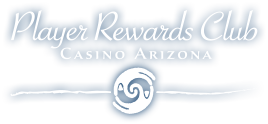
Sign up for our player rewards club TM card and receive dining discounts and exclusive gaming promotions.
Download our app for exclusive offers


480-850-7777
524 north 92nd street, scottsdale, AZ 85256
(loop 101 & mckellips rd)
Free high card flush


If you think you are feeling flushed playing online poker, the chances are pretty good that that is because you are playing galaxy gaming’s hottest internet gambling option, high card flush. This is a unique look at the game of poker that pays off when lady luck rains down flushes and straight flushes, which will make you the winner assuming your flushed hands are better than the dealer.
Called the easiest online gambling game to learn to play by industry experts, high card flush has exploded in popularity over the last few years, and no it is your chance to play this exciting poker variant.
How to play high card flush
Working with a 7-card hand, the goal of the game is to assemble a hand that is better than the dealers utilizing winning combinations that consist solely of flush and straights. An exciting twist on just a portion of the traditionally available poker hands, high card flush demands a new way of thinking about poker play.
When playing the primary game, players earn even money on wagers ranging between $5 and $1,000 against the dealer, while the game has two side bets including the flush side bet and the straight flush side bet. Both the flush and straight flush side bets range between $1 and $25, and pay off proportionately based on the size of the winning hand.
Game play begins with the dealer and players each getting seven cards. You soon note how high card flush differs from traditional poker, because four-of-a-kind and full-house hands don’t matter. Victory in this game requires that players have at least three cards of the same suit, or essentially a three-card flush.
Cards are kept face down, and after the players assemble their, hopefully winning hand, they discard any remaining cards that they will not be using to win the hand.
Then, depending on how many cards are suited, you can raise your wager. For instance, with two, three, or four suited cards, you are only allowed to raise your bet by matching the ante. With five suited cards, they can raise their bet two times the ante. Finally, when holding six or seven suited cards, you can raise your bet by three times the ante.
The dealer then picks up the discards and reveals their hand, and to qualify he must have a nine-high three-card flush for raise bets to qualify against his hand. Following his reveal, the dealer then reveals the players’ cards. In the same manner of blackjack, players must have a better hand than the dealer.
What are the payouts in high card flush
Payouts are designed to please, and as mentioned, prizes are awarded based on the size of the winning bet. As an example, when looking at the payout odds for a flush hand includes:
- 7-card hand 300 to 1 payout
- 6-card hand 100 to 1 payout
- 5-card hand 10 to 1 payout
- 4-card hand 1 to 1 payout
Conversely, should you manage to not only nail the flush, but you also happen to get them all in a row, you can win impressive prize amount based on the length of the run. To know exactly how much you stand to take home, let us look at the pay scale for assembling a straight flush hand:
- 7-card hand 8,000 to 1 payout
- 6-card hand 1,000 to 1 payout
- 5-card hand 100 to 1 payout
- 4-card hand 60 to 1 payout
- 3-card hand 7 to 1 payout
Find out why high card flush is all the rage with both seasoned players and neophytes alike, and see if you can plan your retirement after hitting a 7-card straight flush hand
High card flush collusion
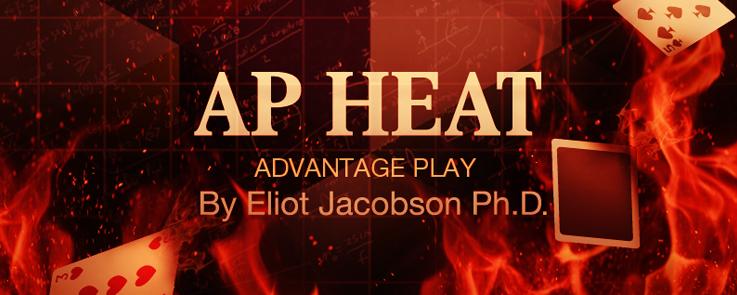

High card flush (HCF) is a relatively new game that distinguished itself by winning “best game” at the cutting edge table games conference in 2012. Recently stephen how demonstrated that HCF has a significant collusion issue (see this post at his blog, discountgambling.Net). With six players at the table sharing full information about their hands (colluding), he stated that these players could each get a 7.3% edge over the house. He gave a practical strategy that yielded a 3.1% player edge. This post presents my analysis of collusion advantage play against HCF.
The rules for HCF are fairly easy to understand. They use the familiar ante/raise structure.
The player makes an “ante” wager.
The player and the dealer receive seven cards, face-down.
The player makes the highest ranking flush from his seven cards. To rank flushes, the following two criteria are used. Flushes are first ranked by the number of cards used in the flush. The more cards, the higher the rank. Flushes with the same number of cards are ranked by their highest card(s).
The player can then fold and surrender his ante or can make a play bet to compete against the dealer.
The play bet amount depends on the number of cards in the players flush. 1x with a two, three or four-card flush. 2x with a five-card flush. 3x with a six or seven-card flush.
The dealer then turns over his cards and makes his best flush. The dealer needs at least a nine-high three card flush or better to qualify.
If the dealer does not qualify, the ante bet wins even money and the play bet pushes.
If the dealer qualifies then the player and dealer compete. If the player wins, his ante and play bets are paid even money. If the player loses, he forfeits his ante and play bets. If the player and dealer push, then the ante and play bets push.
The HCF tables I have seen have spots for six players. Because seven cards are dealt to each hand, a full table will require 42 cards for the player hands. This leaves only ten (10) unknown cards from which the dealer will select seven for his hand. I will call these 10 cards the “remainder.” the small size of the remainder is what gives collusion its power in HCF.
The following table is based on a simulation of two billion (2,000,000,000) rounds of HCF, where the players use perfect collusion strategy. This strategy is unknowable in any practical sense. My program computed optimal strategy on-the-fly for each hand.
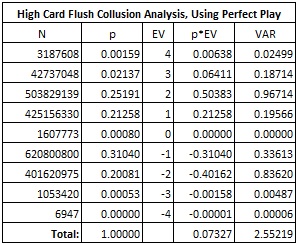
The player edge from perfect six-player collusion is 7.327%.
The standard deviation from perfect six-player collusion is 1.598.
I note that perfect five-player collusion gives a house edge of about 0.61%. There is simply not enough information available to overcome the house edge. In other words, an edge is not possible with five or fewer colluding players at the table.
A high-edge, low volatility game is precisely what aps look for, and HCF appears ripe for the picking. Unfortunately for the AP, there is a practical problem. The perfect strategy that gives the AP a 7.327% edge is unknown. In stephen how’s blog article, he gives a simple strategy for the AP that yields a player edge of about 3.1%. In due respect for how's excellent research, I won’t repeat his strategy here. Instead, I am going to present a somewhat tougher strategy that yields a return over 4% for the AP.
Suppose a team of six aps are at the table. Four of them are assigned to count the suits. There is an AP assigned to “clubs”, one to “diamonds”, one to “hearts” and one to “spades.” the team of six aps shows their cards to each other. Each of the four aps counts the number of cards they see in their respective suit. By doing so, each will arrive at a number from 0 to 13. By subtracting their number from 13, they will get the number of cards of their respective suit in the remainder. This is the number they report to each other.
Note that the four numbers determined by the aps together must sum to 10 (there are 10 cards in the remainder, after all). Here is a complete list of the twenty-three possible suit distributions:
An impractical approach is to give a threshold flush for each of these distributions. In other words, play a given hand or higher depending on the specific distribution from this list. Stephen how understood that this is too much information to convey at the table in real-time. His simple strategy selected a small subset of these distributions and gave a threshold for each. My approach also takes into account that a collusion strategy must be human feasible. However, I will require more effort from the aps.
Imagine an AP counting his given suit and trying to convey that information in real-time to the other aps at the table. What is he going to do? He’s not going to say his number out loud. Also, he doesn’t want to pile some number of chips, from 0 to 10, in front of him to signal his suit count. The method I present requires that the AP signal only the numbers 0, 1, or 2, or else not signal at all.
Here’s how it works. If the AP determines that there are 0, 1 or 2 of his suit in the remainder, then he signals that number to his team. If the AP determines that there are 3 or more of his suit in the remainder, then he does not signal. An AP could discretely signal these values, for example, by touching one of three fingers on his right hand with his right thumb. Or he could make a pile of 0, 1, 2 chips, or no pile at all. Or scratch one of three parts of his face (or not scratch). And so on.
If the AP observes 10 or fewer of his suit in the six hands, then he does not signal.
If the AP observes 11 of his suit, then he signals “2”.
If the AP observes 12 of his suit, then he signals “1”.
If the AP observes 13 of his suit, then he signals “0”.
There are then 18 possibilities for the groups of signals the aps can give. The following table lists these 18 signal groups, together with the remainders that pertain to each:
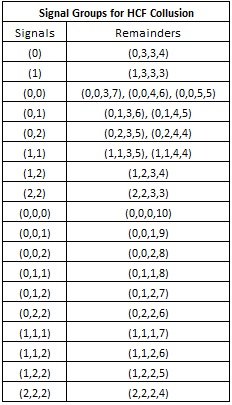
Collusion strategy is based on the signal group the aps determine with their four individual signals. The following table gives collusion strategy for the 18 possible signal groups. I make no claim that this strategy is optimal. I did a lot of “rounding” in the strategy to make the decision points as easy as possible to remember.
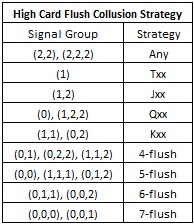
For example, if the signal group is (2, 2 ,2), then the colluding aps should play any hand. If the signal group is (1, 2, 2), then the aps should play a queen high 3-flush or higher. If the signal group is (0,1,2), then any hand less than a 5-flush should be folded.
The following table is based on a simulation of two billion (2,000,000,000) rounds of HCF, where the aps use the signal group collusion strategy given above:
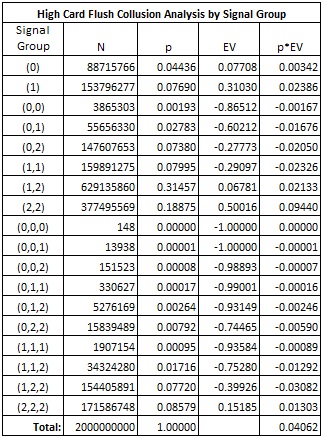
The following table is based on the same simulation of two billion (2,000,000,000) rounds of HCF, where the aps use the signal group collusion strategy. This table is a more traditional combinatorial analysis. It groups the outcomes by the number of units won or lost:
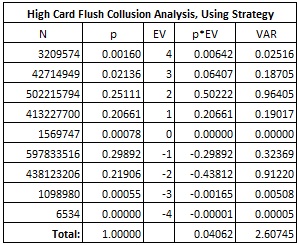
The AP has an edge of 4.062% over the house.
The standard deviation is 1.615.
The group (2,2) is the most player favorable, with an expected return of 0.502 units.
To get an idea of the earning potential, assume six aps occupy a HCF table with a table limit of $100 and that the game pace moves at 40 rounds per hour. Then the aps will win a combined (40) x (6) x ($100) x (4.062%) = $975 per hour from the table. With a $100 max bet, this is probably not worth it for most AP teams. But a table limit of $500 would certainly draw top aps, giving a table-yield of nearly $5000 per hour to the team.
Obviously, folding any 4/5/6-flush is going to look very funny to anyone watching the game. Longevity implies that it will be best to never fold these hands. The cover strategy of never folding a 4-flush or better is as follows:
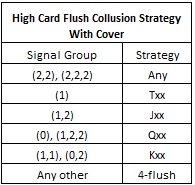
Very little EV is lost using the cover strategy. The following table is based on a simulation of one billion (1,000,000,000) rounds of HCF, using the collusion strategy with cover given above:
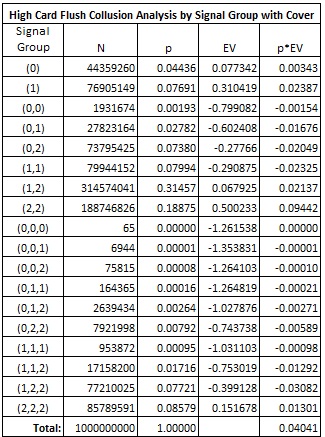
In particular, the AP has an edge of 4.041% over the house using this strategy. The cover strategy is only about 0.02% weaker than the full collusion strategy and is still nearly 1% higher than how's strategy.
Any casino that offers HCF should be informed of its vulnerability and game protection solutions should be put in place. Here are some suggestions:
Don’t worry if five or fewer players are playing.
Reduce the number of play locations from six to five.
Don’t allow players to look at each other’s hands or share information about their hands.
Watch for the situation when every seat is occupied and players are playing at or near the table maximum and are sharing information.
Watch for signals between players.
Watch for any other indication that a team is playing against the game.
High card flush poker | casino de montréal

High card flush
Using seven cards, try to obtain a hand with as many cards of the same suit as possible.
Good to know
Before playing your first game of high card flush, you might benefit from learning about certain notions of the game. These helpful tips and basic rules will give you a sense of what to expect before you get to the casino. Once you are at the table, don’t hesitate to ask the dealer any questions you may have. Helping you understand how the game is played is part of their job.
Taking a seat at the table
High card flush tables can be easily identified by their green playing surface.
First, find a spot that isn’t already occupied. Although players are allowed to occupy several spots at the table, they must give up a spot for a new player if there are no other available spots. A special marker is used to indicate spots reserved for players who have temporarily left the table. These spots may be used until the absent player returns.
The initial bet
Place your money on the table. Never hand it to the dealer. The dealer will exchange your money for value chips and you may place your bet in the betting spot indicated on the table before the first card is dealt. Initial bets cannot be made, changed or withdrawn after that point.
You must respect the minimum and maximum limits indicated at the table when placing your bets.
The cards
High card flush is played with a 52-card deck. In decreasing order, the value of the cards is ace, king, queen, jack, 10, 9, 8, 7, 6, 5, 4, 3 and 2. Aces may also be used to make a straight flush (ace-2-3 to ace-2-3-4-5-6-7).
The game
The dealer deals seven cards face down to each player in turn, and seven cards to himself, also face down. Players may not show their cards or consult with each other. After examining their cards, players may either raise in accordance with the betting table, or fold.
Betting table
An amount equal to the player’s initial bet if the player has two, three or four cards of the same suit
Once or twice the player’s initial bet if the player has five cards of the same suit
Once, twice or three times the player’s initial bet if the player has six or seven cards of the same suit
Once all players have made their choice and placed their hole cards face down on the table, the dealer reveals his cards. To qualify, the dealer’s seven-card hand must contain at least three cards of the same suit. Note that, should the dealer’s hand contain only three cards of the same suit, the highest ranking of those cards must be a 9 or higher. If the dealer’s hand qualifies, he reveals, in turn, the cards of each player who raised, comparing the rank of each player’s hand to his own. A player may fold before the dealer reveals that player’s hand. In that event, the cards of the concerned player are not revealed to the other players.
How to play high card flush
What is high card flush?
High card flush is a poker variation that first started circulating across the USA casinos several years ago (around 2011), increasing in popularity after being introduced at the M resort in las vegas. The game is a registered trademark of galaxy gaming inc and has a structure similar to caribbean stud and three card poker, but it employs a different hand-ranking.
What is a flush?
There are three types of flush hands in poker.
Out of the 3, flush has the lowest rank, and it consists of any 5 cards that have the same suit.
The straight flush hand is stronger, as it has 5 cards that are both suited and sequential, for example, suited Q-J-10-9-8. This would be called a queen high straight flush.
The royal flush or royal straight flush is the ace high straight flush and the highest-ranking poker hand: A-K-Q-J-10.
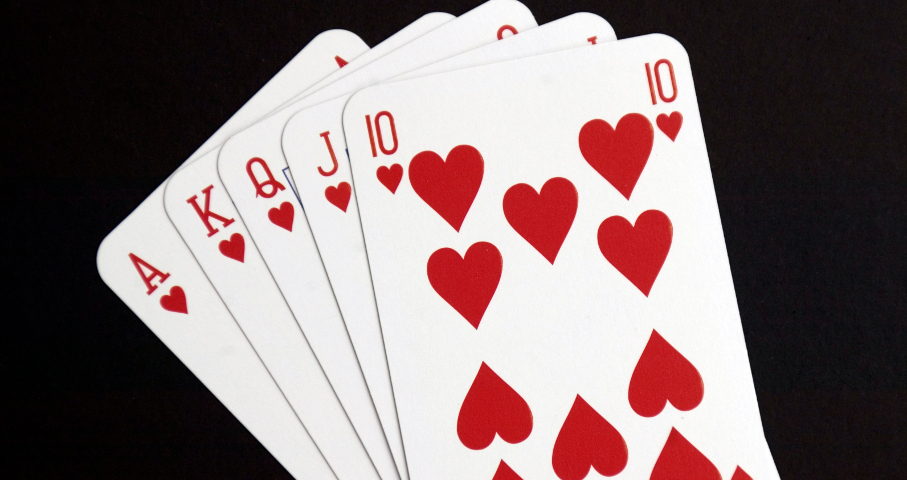
Ah, the royal flush. Best damn poker hand you’re ever going to come across!
How to play high card flush – basic rules and table layout
The rules are fairly simple. Unlike the texas hold’em where you must measure your hand against multiple opponents, you only have one rival in high card flush, and that’s the dealer. The session starts with the ante bet, followed by the optional side bets: flush bonus and straight flush bonus.
The dealer will then draw 7 cards for the players and 7 more for the house, placing them on the table face down. The objective is to land as many suited cards as possible – preferably all 7.
Once the cards are revealed, you will have the option to fold the hand and lose your ante or proceed to stage 2 of the game and raise the bet.
The amount that can be added to your ante will depend on the number of suited cards:
- Flush with 2 – 4 cards: x1 bet increase
- Flush with 5 cards: up to x2 bet increase
- Flush with 6 – 7 cards: up to x3 bet increase
The dealer will then reveal his hand and the bets will be settled accordingly. To qualify, the dealer must have a 3-card flush with at least one 9 (or higher card), otherwise, you will receive a payout on your ante and the raise bet will push.
If both you and the dealer have the same number of suited cards, the rank of the cards will determine the winner. The flush hands of the same rank will be resolved as a tie.
Bonus bets
Bonus bets are resolved independently from the ante (1:1) and settled according to the different payout tables:
Flush bonus:
- 4 cards: even pay
- 5 cards: 10:1
- 6 cards: 100:1
- 7 cards: 300:1
Straight flush bonus:
- 3 cards: 7:1
- 4 cards: 60:1
- 5 cards: 100:1
- 6 cards: 1,000:1
- 7 cards: 8,000:1
The players are allowed to play the flush hands separately, which means that if you hold a 4-card heart flush and a 3-card spade straight flush in a single hand, you can challenge the dealer with the 4-card flush, and win the straight flush bonus bet on the 3-card spade straight flush hand at the same time.
High card flush tips and strategies
The high card flush strategy is extremely simple. According to the charles mousseau system, you should always raise on 10-8-6 or higher hand, betting the maximum stake. This will reduce the house edge to 0.6%.
For instance, if you decide to use this strategy, you would raise on J-3-2 but fold on 10-7-5.
There is also a more advanced strategy, primarily based on the ranking of the cards forming the flush:
- Raise on J-3-2 to A-K-Q
- Consider the non-suited cards on 10-3-2 to 10-9-8
- Fold on 4-3-2 to 9-8-7
If we were to compare the strategy for two hands that have the same 10-8-6 flush but different non-suited cards, we would find that the expected value or the average return on a dollar bet could, theoretically, be quite different:
- 10-8-6 (hearts) with J of spades, A of diamonds, Q of diamonds, and J of clubs – call
- 10-8-6 (hearts) with 7, 4, and 2 of diamonds and 9 of clubs – fold
The reason you should raise on the first hand is that the presence of high cards in your hand automatically reduces the potential value of the dealer’s hand.
In the second hand, the low cards weaken the 10-high flush, increasing the dealer’s chances of beating you with a higher-ranking flush combo.

Following the charles mousseau system, you would think for a split second to raise. Nope, nope nope. They’re nice and all, but not suited.
Finally, most players will advise you to simply avoid folding (if your budget can take it) and take a chance – losing hands are inevitable at times but taking a risk is what poker is all about, right?
Conclusion, and where to now?
As you can see from this article, there really isn’t a ton to high card flush. Just a couple easy to remember rules and you’ll be good to go, ready to clean up the tables yourself!
Speaking of cleaning up the tables…
We will only send you to sites where if you do win, you will get paid!
That is to say, we will only send you off to sites and casinos that are actually trustworthy, that we use ourselves, and have earned the respect of gamers everywhere. Keep that in mind while we tell you this.
None of the sites we support and back up offer high card flush.
Well, not at the time of this writing anyway. As soon as any of them do, we will update this immediately. We just want to make sure that if you run off and do your own thing and play this game ‘somewhere else’, that you’re still ready to go and have a good strategy under your belt and that you’re ready to go.
Until then, why not check out some of these casinos here that do offer up a myriad of other table games, from 21 to zappit! Click on each of these names to check out a full review of each!
Bovada
A personal favorite of many, us here in the office included. US players more than welcome, unless they live in delaware, maryland, nevada, or new jersey. Thank your lawmakers for keeping you safe from your own money decisions.
At bovada, not only is there a constant offering of different types of poker tournaments going on for you to choose from, but you can also take part in some live dealer action as well.
Joining now can also grant you a super nice match bonus of up to $1000 if you use the code NEWWELCOME! This is actually redeemable 3 times as well!
Betonline
Like bovada in the sense that they are a top-notch casino that also have a sweet sportsbook to go along with them offering you lines on everything from wagering on cricket matches to killing some time playing the slots!
Use bitcoin, bitcoin cash, ethereum, DASH or litecoin? Use the code CRYPTO100 and get a match bonus of 100% up to $1000!
Ignition
- Fast, smooth interface
- Anonymous tables
- Sync breaks
- Quick chat feature
And that list actually goes on and on as far as the eye can see over at ignition and the amazing poker room that they offer their customers.
Ignition also offers you a $1000 welcome bonus when joining up over at their poker room.
Here’s how it works with ignition.
Join ignition casino by opening up your account.
When you make your first deposit you will be eligible to receive your poker welcome bonus. Simply claim it from the available bonuses list when making your deposit and start playing to begin unlocking the bonus. You’ll get $5 released for every 150 ignition miles you earn while playing poker.
Mybookie
Of the places on this short list, you may want to look into mybookie if you’re more into “different types” of games than the regular offerings of other casinos.
Here, you will find things like max quest, keno, scratcherz, just little things like that that will give you a break from the norm.
If that’s not your thing, that’s okay. You’ll still feel right at home with more traditional slots, sportsbook and poker room offerings!
Make sure you check out all of the bonuses and promos over at mybookie, but we wanted to point out the rebate special mondays. That’s right. On your gameplay on mondays, get a rebate of 10% back. Find THAT at any other casino!
As always, with these casinos as well as any others you visit, be sure to check out their terms and conditions!
Don’t go to far without also taking a look at some more in our series of “how to”s –
so, let's see, what we have: check out how to play high card flush with all the infomation you need from rules, strategies, payouts, house edge and more at vegasslots table games. At casino game high card flush
No comments:
Post a Comment